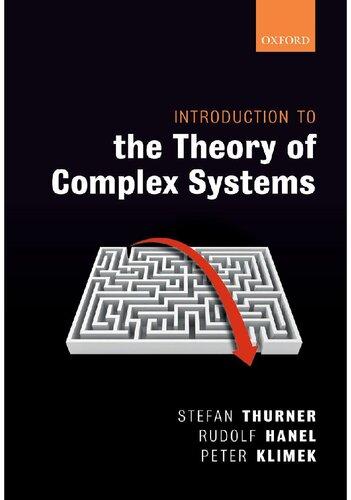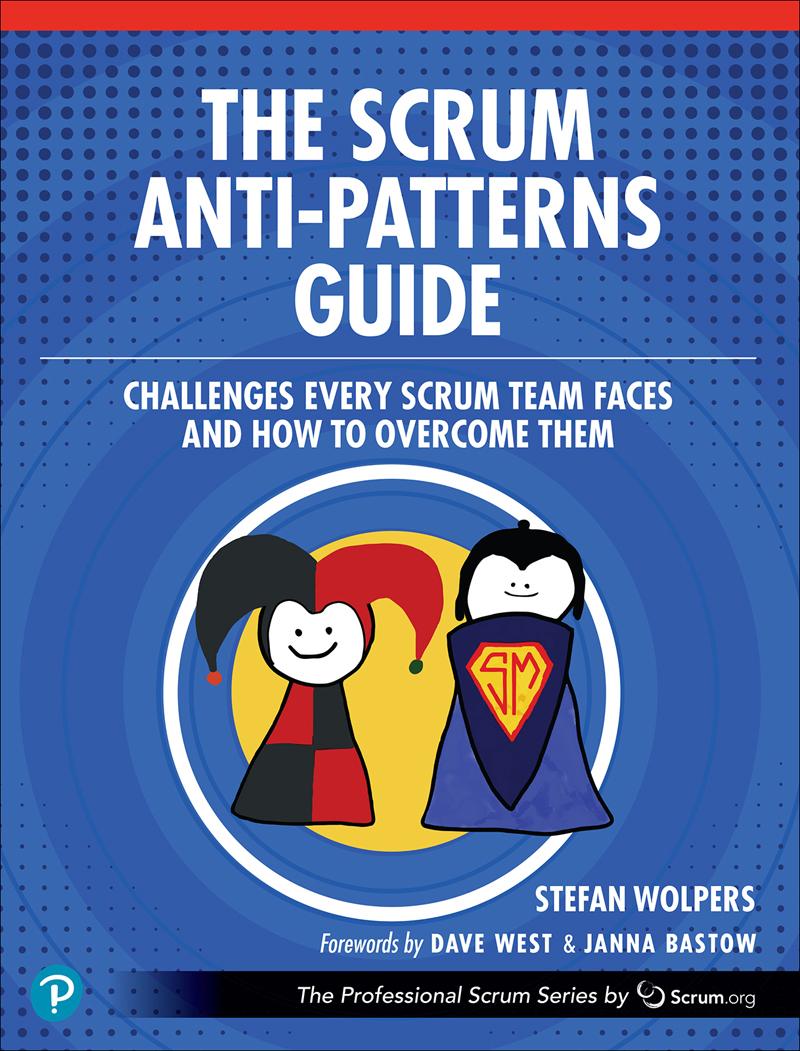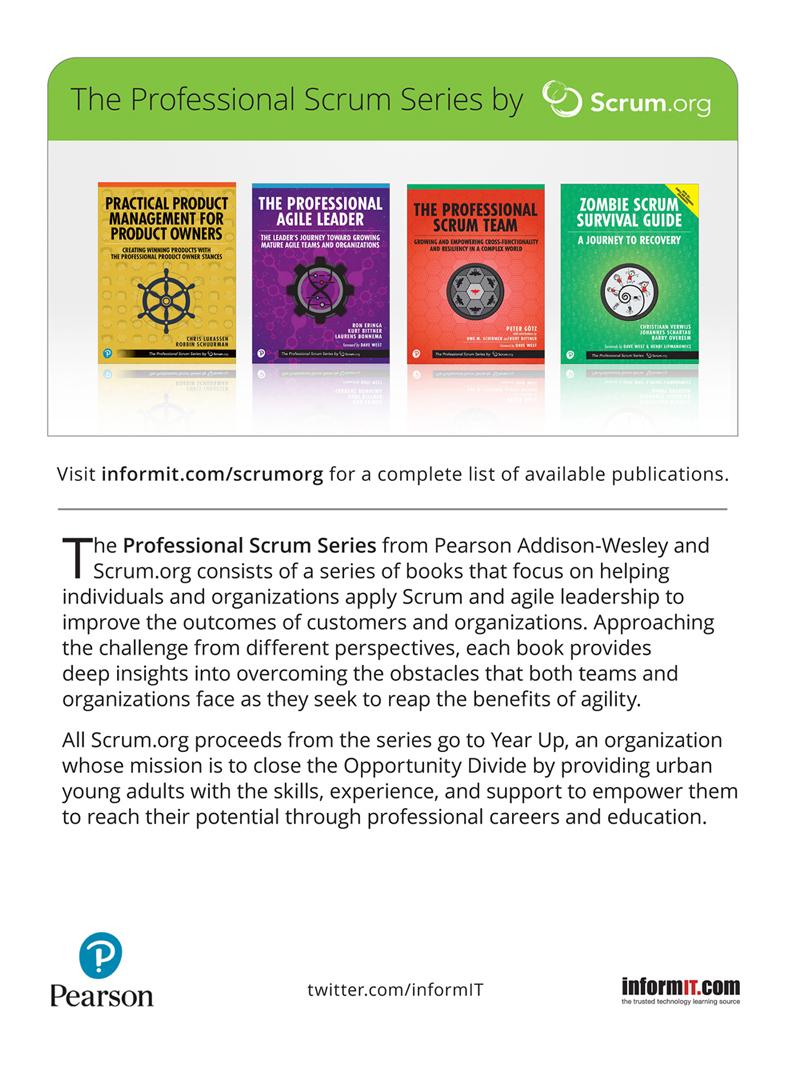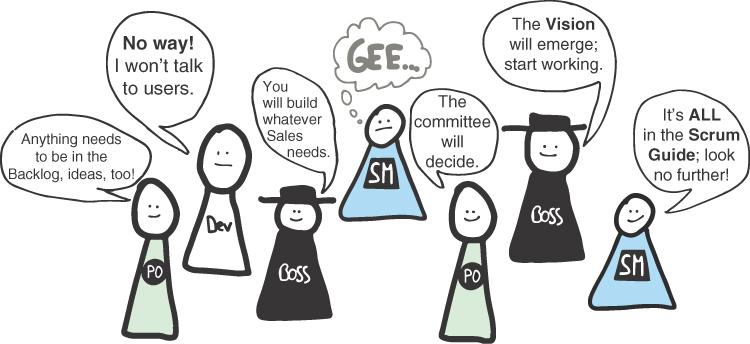About This eBook
ePUB is an open, industry-standard format for eBooks. However, support of ePUB and its many features varies across reading devices and applications. Use your device or app settings to customize the presentation to your liking. Settings that you can customize often include font, font size, single or double column, landscape or portrait mode, and figures that you can click or tap to enlarge. For additional information about the settings and features on your reading device or app, visit the device manufacturer’s Web site.
Many titles include programming code or configuration examples. To optimize the presentation of these elements, view the eBook in singlecolumn, landscape mode and adjust the font size to the smallest setting. In addition to presenting code and configurations in the reflowable text format, we have included images of the code that mimic the presentation found in the print book; therefore, where the reflowable format may compromise the presentation of the code listing, you will see a “Click here to view code image” link. Click the link to view the print-fidelity code image. To return to the previous page viewed, click the Back button on your device or app.
Stefan Wolpers has a remarkable ability to highlight underlying traps and issues for stakeholders, teams, and process. In The Scrum Anti-Patterns Guide, Wolpers documents sources of waste and frustration, an amazing compendium of typical ways progress becomes blocked. Depressing! He doesn’t leave us there though. He also recommends insightful remedies. Uplifting!
—Diana Larsen, speaker, advisor, author at dianalarsen.com
This book is an invaluable treasure for every Scrum practitioner as it shows not only what can (and does) go wrong in Scrum teams, but also how to avoid and overcome these traps. Stefan shares his in-depth experience and provides concrete tips to help the whole Scrum team grow.
—Jutta Eckstein, coauthor of Company-Wide Agility with Beyond Budgeting, Open Space & Sociocracy
Stefan Wolpers’ comprehensive collection of common Scrum anti-patterns is a great resource for anybody who wants to improve their application of Scrum and fully leverage the framework. Highly recommended!
—Roman Pichler, author of Agile Product Management with Scrum
There is so much potential with Scrum that sadly ends up wasted because teams misuse the process. Wolpers does a masterful job of identifying the anti-patterns that cause this waste and points out exactly how to overcome each one. This is a must-have book for all Scrum practitioners.
—Jeff Gothelf, author of Lean UX and Sense & Respond
The first step to fixing a problem is acknowledging you have a problem. Stefan Wolpers’ wonderful book is the ultimate compendium of Scrum antipatterns. After exposing common Scrum problems, the book serves as a
cunning companion that masterfully guides you to transcend the dysfunctions it lays bare.
—Maarten Dalmijn, author of Driving Value with Sprint Goals
Stefan’s groundbreaking book The Scrum Anti-Patterns Guide flips the script, spotlighting Scrum pitfalls over best practices. Packed with vivid examples, clear illustrations, and robust theory, this book accelerates learning by showing you what NOT to do. Not only insightful but delightfully entertaining!
—Jorgen Hesselberg, author of Unlocking Agility: An Insider’s Guide to Agile Enterprise Transformation and Co-Founder of Comparative Agility
For years I’ve admired Stefan Wolpers’ shared anti-patterns of various roles and activities within and around Scrum teams. His insights are simple, insightful, and powerful, while always rooted in his practical experience. He also artfully balances the anti-patterns away from criticism and toward improvement. This book contains his collective wisdom and I couldn’t recommend it more to anyone desiring to improve their Scrum.
—Bob Galen, Principal Coach at Agile Moose
Pearson’s Commitment to Diversity, Equity, and Inclusion
Pearson is dedicated to creating bias-free content that reflects the diversity of all learners. We embrace the many dimensions of diversity, including but not limited to race, ethnicity, gender, socioeconomic status, ability, age, sexual orientation, and religious or political beliefs.
Education is a powerful force for equity and change in our world. It has the potential to deliver opportunities that improve lives and enable economic mobility. As we work with authors to create content for every product and service, we acknowledge our responsibility to demonstrate inclusivity and incorporate diverse scholarship so that everyone can achieve their potential through learning. As the world’s leading learning company, we have a duty to help drive change and live up to our purpose to help more people create a better life for themselves and to create a better world.
Our ambition is to purposefully contribute to a world where:
Everyone has an equitable and lifelong opportunity to succeed through learning.
Our educational products and services are inclusive and represent the rich diversity of learners.
Our educational content accurately reflects the histories and experiences of the learners we serve.
Our educational content prompts deeper discussions with learners and motivates them to expand their own learning (and worldview).
While we work hard to present unbiased content, we want to hear from you about any concerns or needs with this Pearson product so that we can investigate and address them.
Please contact us with concerns about any potential bias at https://www.pearson.com/report-bias.html.
Contents
Foreword by Dave West
Foreword by Janna Bastow
Preface
Acknowledgments
About the Author
Introduction
Chapter 1 Scrum Master Anti-Patterns
Introduction
The Scrum Master According to the Scrum Guide
Possible Reasons Why Scrum Masters Leave the Path Anti-Patterns from Acting as an Agile (Line) Manager
Scrum Master Anti-Patterns by Scrum Events
The Sprint Planning
The Sprint
The Daily Scrum
The Retrospective
Food for Thought
Conclusion
Chapter 2 Product Owner Anti-Patterns
Introduction
The Role of the Product Owner According to the Scrum Guide
Product Backlog and Refinement Anti-Patterns
Sprint Planning Anti-Patterns
Sprint Anti-Patterns
Product Owner Anti-Patterns during the Daily Scrum
Sprint Review Anti-Patterns
Food for Thought
Conclusion
Chapter 3 Scrum Developer Anti-Patterns
Introduction
The Role of the Developers in Scrum
Developer Anti-Patterns by Scrum Events
Sprint Anti-Patterns
Sprint Planning Anti-Patterns of the Developers
Anti-Patterns during the Daily Scrum
Developer Anti-Patterns Concerning the Sprint Review
Sprint Retrospective Anti-Patterns of Developers
Anti-Patterns at the Product Backlog Level
Food for Thought
Conclusion
Chapter 4 Scrum Stakeholder Anti-Patterns
Introduction
Common Scrum Stakeholder Anti-Patterns
Scrum Stakeholder Anti-Patterns at the Organizational Level
Sprint Anti-Patterns of the IT Management
Incentivized Scrum Stakeholder Anti-Patterns
Stakeholder Anti-Patterns at Scrum Event Level
Product Backlog and Refinement Anti-Patterns
The Daily Scrum
Sprint Planning Anti-Patterns of Stakeholders
The Sprint Review
The Sprint Retrospective
Food for Thought
Conclusion
Chapter 5 Sprint Anti-Patterns
Introduction
The Purpose of the Sprint
Sprint Anti-Patterns
Sprint Anti-Patterns of the Product Owner
Sprint Anti-Patterns of the Developers
Sprint Anti-Patterns of the Scrum Master
Sprint Anti-Patterns of the Scrum Team
Sprint Anti-Patterns of the IT Management
Sprint Review Anti-Patterns of Stakeholders
Food for Thought
Conclusion
Chapter 6 Sprint Planning Anti-Patterns
Introduction
Preparing the Sprint Planning
Sprint Planning Anti-Patterns
Sprint Planning Anti-Patterns of the Developers
Sprint Planning Anti-Patterns of the Product Owner
Sprint Planning Anti-Patterns of the Scrum Team
Sprint Planning Anti-Patterns of the Scrum Master
Food for Thought
Conclusion
Chapter 7 Daily Scrum Anti-Patterns
Introduction
The Purpose of the Daily Scrum According to the Scrum Guide
Daily Scrum Anti-Patterns
Daily Scrum Anti-Patterns of the Scrum Team
Daily Scrum Anti-Patterns of the Developers
Daily Scrum Anti-Patterns of the Product Owner
Daily Scrum Anti-Patterns of the Scrum Master
Daily Scrum Anti-Patterns of the Stakeholders
Food for Thought
Conclusion
Chapter 8 Sprint Review Anti-Patterns
Introduction
The Scrum Guide on the Sprint Review
Sprint Review Anti-Patterns
Sprint Review Anti-Patterns of the Scrum Team
Sprint Review Anti-Patterns of the Product Owner
Sprint Review Anti-Patterns of the Developers
Sprint Review Anti-Patterns of the Stakeholders
Food for Thought
Conclusion
Chapter 9 Sprint Retrospective Anti-Patterns
Introduction
The Scrum Guide on the Sprint Retrospective
Sprint Retrospective Anti-Patterns
Sprint Retrospective Anti-Patterns of the Scrum Team
Sprint Retrospective Anti-Patterns of the Scrum Master
Sprint Retrospective Anti-Patterns of the Organization
Food for Thought
Conclusion
Chapter 10 Product Backlog and Refinement Anti-Patterns
Introduction
The Product Backlog According to the Scrum Guide
Common Product Backlog Anti-Patterns
General Product Backlog Anti-Patterns
Product Backlog Anti-Patterns of the Product Owner
Product Backlog Anti-Patterns of the Developers
Product Backlog Anti-Patterns of the Scrum Team
Food for Thought
Conclusion
Chapter 11 Sprint Backlog Anti-Patterns
Introduction
Sprint Backlog Anti-Patterns
Sprint Backlog Anti-Patterns of the Scrum Team
Sprint Backlog Anti-Patterns of the Developers
Sprint Backlog Anti-Patterns of the Product Owner
Food for Thought
Conclusion
Chapter 12 Increment Anti-Patterns
Introduction
The Purpose of the Increment According to the Scrum Guide
Increment Anti-Patterns
Increment Anti-Patterns by the Scrum Team
Increment Anti-Patterns of the Stakeholders or the Organization
Food for Thought
Conclusion
Chapter 13 Product Goal Anti-Patterns
Introduction
The Purpose of the Product Goal According to the Scrum Guide
Product Goal Anti-Patterns
Product Goal Anti-Patterns of the Product Owner
Product Goal Anti-Patterns of the Scrum Team
Product Goal Anti-Patterns of the Organization
Food for Thought
Conclusion
Chapter 14 Sprint Goal Anti-Patterns
Introduction
How to Create Sprint Goals
Sprint Goal Anti-Patterns
Sprint Goal Anti-Patterns of the Scrum Team
Sprint Goal Anti-Patterns Induced by the Organization
Sprint Goal Anti-Patterns by the Developers
Sprint Goal Anti-Patterns by the Product Owner
Food for Thought
Conclusion
Chapter 15 Definition of Done Anti-Patterns
Introduction
Creating a Successful Definition of Done
Definition of Done Anti-Patterns
Definition of Done Anti-Patterns of the Developers
Definition of Done Anti-Patterns of the Scrum Team
Definition of Done Anti-Patterns of the Organization
Definition of Done Anti-Patterns of the Product Owner
Food for Thought
Conclusion
Appendix A How to Sabotage Scrum Masters and Product Owners at an Organizational Level
Appendix B Toolbox
Index
Foreword by Dave West
Ken Schwaber, the co-creator of Scrum, often says, “Scrum takes minutes to learn but a lifetime to master.” This saying describes the paradox of Scrum: It is a simple framework that is easy to learn and understand, but practicing it well is challenging and takes time. Scrum is not complex, but the environment in which it is employed can be very complex. The complexity that Scrum works within includes the team, the organization, the problem domain, the solution domain, and the stakeholders. Each of these areas can manifest challenges to empiricism, self-management, and the ability to improve. Scrum Teams must overcome these challenges to achieve their full potential using Scrum.
As CEO at Scrum.org, I have seen first-hand the struggles of Scrum Teams. I have seen Product Backlogs that are merely lists of work to be done and Sprint Plans that were dictated to the team instead of being developed by the team to achieve a Sprint Goal. I have seen Product Increments that are intentionally not ready for users and Sprint Reviews in which Stakeholders simply look for progress against a plan instead of understanding the value that was delivered. The list goes on and on. The results in all these situations could have been better for everyone involved if they had understood the common dysfunctions of Scrum Teams and their organization and how to overcome them.
Many organizations look to consultants and practitioners experienced with Scrum to help them avoid these and many other dysfunctions. That’s nice if you can find them; already having made the mistakes and learning from them can help prevent them in the future. In the absence of this personal experience, books, blogs, and articles written by experienced practitioners
can help you understand where teams and their organizations can and often do go wrong and what to do about them.
In this book, Stefan describes the anti-patterns he has observed and provides simple and practical advice on their resolution. He has structured the book around the elements of Scrum to make it easy for you, the reader, to easily find anti-patterns. For example, if you are new to the Sprint Review or struggling with it, you can quickly dip into that chapter and see if anything resonates.
Each chapter has many pearls of wisdom, and I have experienced many examples in the organizations I have visited. Still, my favorite two are Scrum Sprint Planning and Sprint Review. Both these events are crucial to the success of Scrum but often need to be better executed, and improvements in these two events have a massive impact on the value of the Increment, team morale, and the relationship with Stakeholders.
In the agile community, we spend much time moaning about the lack of success, blaming the big things. Things include legacy systems, existing processes, HR practices, incentive programs, organization structures, job titles, and team structure. And, yes, many of those things make agile very difficult. But, at the heart of agile is the idea that teams break things down, deliver frequently, and do what they need to do. Agile is much more than teams; but it starts and finishes with teams. How they work, how they collaborate, and the choices they make collectively make them more or less agile. This book is all about those choices. And the first step in any choice is knowing you have a choice to make. A patterns approach is a great way to identify those issues and the choices you have to make.
The phrase “dream big, but start small” is an excellent guide to using Scrum, and I hope this book can provide you with some tips and a frame for changing the world, one choice at a time.
ScrumOn!
— Dave West
October 2023 Weston, MA
Foreword by Janna Bastow
I once found myself amidst the bustling energy of a newly funded startup, right at the awkward juncture of scaling. We had a couple dozen developers who seemed to know their stuff but we weren’t jiving as a team yet. Our boss brought in a Scrum Master, complete with a pile of certifications and textbooks and promises of a transformation. And indeed, we did see a transformation! I’ve never seen a group of four development teams whipped into shape so fast. Their velocity was off the charts… and yet they were delivering absolutely nothing of value. The disconnect between development processes and product needs was massive, so no impact was being made. It was a classic case of a Scrum anti-pattern—mistaking motion for progress.
I wish I’d read this book all those years ago, as Stefan Wolpers’ guide would have saved us from a lot of wasted effort.
Over the years, I’ve worked with hundreds of companies, and I’ve seen Scrum fail in a spectacular kaleidoscope of ways. Stefan spots all of these pervasive anti-patterns and calls them out, guiding the reader on how to avoid them at every turn. This isn’t just another book on Scrum; it’s a lifeline for those of us who have found ourselves trapped in a quagmire of “doing Scrum right” but not reaping the benefits. At its heart, this book is all about impact. It’s about making use of the tools and processes that Scrum gives us to get the most out of it for your team, your product, and your business.
But Stefan doesn’t stop at the basics. He delves deep, guiding you through the good, the bad, and the downright ugly metrics that will shape your Scrum journey. He tackles tough subjects around stakeholder management
with good humor. And for those grappling with the realities of today’s distributed teams, there’s invaluable advice on establishing Communities of Practice and effective remote management.
One of the standout features that you’ll love with this guide is the sheer practicality. It’s the kind of book you’ll want to keep within arm’s reach on your desk, not just for yourself, but to share with your developers, your product owner, your Scrum Master, and anyone else baffled by the Scrum process. Stefan’s humorous takes on how to (hypothetically) sabotage your product owner or Scrum Master are not only entertaining but serve as useful cautionary tales, highlighting what not to do (or what to stop doing!). And let’s not forget the iconic comics sprinkled throughout the book. These illustrations, both witty and insightful, perfectly capture the essence of the situations discussed, making your journey to better Scrum more digestible.
In classic Stefan fashion, there’s no beating around the bush. Every page, every chapter, is packed with value, devoid of unnecessary fluff. It’s a testament to his expertise and his commitment to delivering actionable insights to the Scrum community.
In essence, if you’re looking to make a tangible difference with your work, this book is a must-read. Dive in, apply its lessons, and see the transformation for yourself.
Janna Bastow, Co-founder & CEO, ProdPad
Preface
The Scrum Anti-Patterns Guide offers a different perspective on how to apply Scrum successfully by applying the principle of “inversion.” Instead of explaining how to apply Scrum properly, the book looks at the many things that may go wrong when practicing Scrum—the anti-patterns.
The principle of inversion refers to a change in order or position, specifically, changing perspective to gain different insights. This principle is a powerful learning tool because it encourages viewing problems from an alternative standpoint, revealing new dimensions and possible solutions.
In the ideal case, inversion helps us confront the constraints, potential pitfalls, or worst-case scenarios upfront, which can illuminate the path to success by highlighting what to avoid.
Even under less-than-ideal circumstances, the principle of inversion can still provide immense value, even when you’re already making the mistakes you should avoid. Here’s how:
Identifying root causes: Through inversion, you can better understand the root causes of the mistakes. Often, we focus on symptoms rather than causes. By asking, “What actions or conditions led to these mistakes?” you can start to address the underlying issues.
Preventing recurrence: Once the mistakes are made, inversion can help prevent them from recurring. By analyzing what led to the error, you can implement safeguards and checkpoints to prevent the same mistakes in the future.
Learning and adaptation: Making mistakes is a part of the learning process. Inversion promotes learning from these mistakes and adapting your practices accordingly. The goal is not to avoid all mistakes but to continuously learn and improve.
Prioritization of actions: Not all mistakes have the same impact. Inversion can help identify the most damaging errors, effectively prioritizing countermeasures.
Promoting a proactive mindset: Rather than merely reacting to errors, inversion encourages a proactive mindset, fostering preventative actions and forward-thinking solutions.
Consequently, applying the inversion principle to Scrum can produce profound results as Scrum is grounded in feedback-informed learning and continuous improvement, concepts that align well with inversion.
The book started as a series of blog posts in 2017/2018 when I began curating all my observations over the years, particularly in larger organizations.
Register your copy of The Scrum Anti-Patterns Guide on the InformIT site for convenient access to updates and/or corrections as they become available. To start the registration process, go to informit.com/register and log in or create an account. Enter the product ISBN (9780137977963) and click Submit. Look on the Registered Products tab for an Access Bonus Content link next to this product, and follow that link to access any available bonus materials. If you would like to be notified of exclusive offers on new editions and updates, please check the box to receive email from us.















